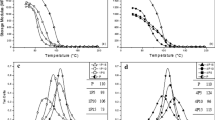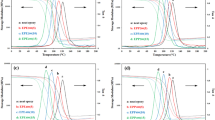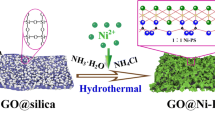Abstract
Polyethylene Glycol (PEG-1000) was considered as an effective thermoplastic filler for epoxy systems. Current study tries to portray both the reinforcing and catalytic efficiency of PEG-1000 in the Diglycidyl ether of Bisphenol A based epoxy (DGEBA) and Diethyl toluenediamine (DETDA) based system. The effectiveness of the combination of PEG/DGEBA/DETDA this trio system in the epoxy toughening were also elucidated systematically. PEG-1000 enhanced tensile strength and fracture toughness of epoxy by 8.7% and 213%, respectively. The thermo-mechanical characteristics of the PEG/epoxy systems were thoroughly investigated with the help of theoretical models.











Similar content being viewed by others
References
Park YT et al (2015) Epoxy toughening with low graphene loading. Adv Funct Mater 25:575–585
Mirmohseni A, Zavareh S (2011) Modeling and optimization of a new impact-toughened epoxy nanocomposite using response surface methodology. J Polym Res 18:509–517
Jayan JS, Pal K, Saritha A, Deeraj BDS, Joseph K (2021) Graphene oxide as multi-functional initiator and effective molecular reinforcement in PVP/epoxy composites. J Mol Struct 1230:129873
Jayan JS, Saritha A, Deeraj BDS, Joseph K (2020) Triblock copolymer grafted Graphene oxide as nanofiller for toughening of epoxy resin. Mater Chem Phys 122930
Gu J et al (2017) Highly thermally conductive flame-retardant epoxy nanocomposites with reduced ignitability and excellent electrical conductivities. Compos Sci Technol 139:83–89
Dean JM, Grubbs RB, Saad W, Cook RF, Bates FS (2003) Mechanical properties of block copolymer vesicle and micelle modified epoxies. J Polym Sci Part B Polym Phys 41:2444–2456
Gu H et al (2017) A low loading of grafted thermoplastic polystyrene strengthens and toughens transparent epoxy composites. J Mater Chem C 5:4275–4285
Wu G, Gu J, Zhao X (2007) Preparation and dynamic mechanical properties of polyurethane-modified epoxy composites filled with functionalized fly ash particulates. J Appl Polym Sci 105:1118–1126
Njuguna J, Pielichowski K, Alcock JR (2007) Epoxy-based fibre reinforced nanocomposites. Adv Eng Mater 9:835–847
Varley RJ, Craze DA, Mouritz AP, Wang CH (2013) Thermoplastic healing in epoxy networks: exploring performance and mechanism of alternative healing agents. Macromol Mater Eng 298:1232–1242
Jayan S, Appukuttan J, Bds S, D., Joseph K (2020) Graphene oxide as a prospective graft in PEG for enhancing the toughness of epoxy nanocomposites. Polym Eng Sci. https://doi.org/10.1002/pen.25335
Barzoki PK, Rezadoust AM, Latifi M, Saghafi H (2018) The experimental and numerical study on the effect of PVB nanofiber mat thickness on interlaminar fracture toughness of glass/phenolic composites. Eng Fract Mech 194:145–153
Wang X et al (2017) Toughening and reinforcing of benzoxazine resins using a new hyperbranched polyether epoxy as a non-phase-separation modifier. Polym (Guildf) 121:217–227
Yang G, Zheng B, Yang J, Xu G, Fu S (2008) Preparation and cryogenic mechanical properties of epoxy resins modified by poly (ethersulfone). J Polym Sci Part A Polym Chem 46:612–624
Biswas B, Kandola BK (2011) The effect of chemically reactive type flame retardant additives on flammability of PES toughened epoxy resin and carbon fiber-reinforced composites. Polym Adv Technol 22:1192–1204
Parzuchowski PG, Kiźlińska M, Rokicki G (2007) New hyperbranched polyether containing cyclic carbonate groups as a toughening agent for epoxy resin. Polym (Guildf) 48:1857–1865
Qin C, Shen J, Hu Y, Huang W, Ye M (2008) Miscibility, crystallization behavior and specific intermolecular interactions in thermosetting polymer blends of novolac epoxy resin and polyethylene glycol. Polym Eng Sci 48:556–563
Zhang B et al (1998) Application of a series of novel chain-extended ureas as latent‐curing agents and toughening modifiers for epoxy resin. J Appl Polym Sci 69:339–347
Zavareh S, Samandari G (2014) Polyethylene glycol as an epoxy modifier with extremely high toughening effect: formation of nanoblend morphology. Polym Eng Sci 54:1833–1838
Guzel G, Deveci H (2015) Physico-mechanical, thermal, and coating properties of composite materials prepared with epoxy resin/steel slag. Polym Compos
Feng Q, Yang J, Liu Y, Xiao H, Fu S (2014) Simultaneously enhanced cryogenic tensile strength, ductility and impact resistance of epoxy resins by polyethylene glycol. J Mater Sci Technol 30:90–96
Zhang J et al (2023) Properties improvement of composite layer of cryo-compressed hydrogen storage vessel by polyethylene glycol modified epoxy resin. Int J Hydrogen Energy 48:5576–5594
Hu B, Xia H, Zhang Q, Liu F, Ni Q-Q (2023) Multi-stimuli temperature, reusable, recyclable, and healable shape-memory epoxy–PEG multifunctional films by regulating polyethylene glycol. Prog Org Coatings 174:107309
Hu B, Xia H, Liu F, Ni Q-Q (2022) Heat-stimuli controllability of shape memory thermoplastic epoxy filaments by adding polyethylene glycol. Polym (Guildf) 250:124818
Wang T, Wang C, Chen K, Liu X, Huang Z (2022) Preparation, thermal, and mechanical properties of polyethylene glycol/expoxy resin composites as form-stable phase change materials. Polym Eng Sci 62:520–529
Zhang Y, Wang K, Sun Y, Xu M, Cheng Z (2022) Novel biphasically and reversibly transparent phase change material to solve the thermal issues in transparent electronics. ACS Appl Mater Interfaces 14:31245–31256
Jayan JS, Saritha A, Deeraj BDS, Joseph K (2023) Amphiphilic Block Copolymer Grafted Multiwalled Carbon Nanotube based hierarchical nanohybrids for effective epoxy toughening. ACS Appl Eng Mater. https://doi.org/10.1021/acsaenm.3c00135
Jayan JS, Deeraj BDS, Saritha A, Joseph K (2020) Theoretical modelling of kinetics of glass transition temperature of PEG toughened epoxy. Plast Rubber Compos 1–8
Jayan JS, Saritha A, Deeraj BDS, Joseph K (2022) Modelling of the Rheological Behaviour of Epoxy-Polyethylene Glycol-1000 blends. Top Catal 1–12
Jouyandeh M et al (2019) Curing epoxy with polyethylene glycol (PEG) surface-functionalized NixFe3-xO4magnetic nanoparticles. Prog Org Coatings 136:105250
Yarahmadi E, Didehban K, Shabanian M, Saeb MR (2018) High-performance starch-modified graphene oxide/epoxy nanocomposite coatings: a glimpse at cure kinetics and fracture behavior. Prog Color Color Coatings 11:55–62
Jouyandeh M et al (2019) Curing epoxy resin with anhydride in the presence of halloysite nanotubes: the contradictory effects of filler concentration. Prog Org Coatings 126:129–135
Gu X, Zhang Z, Yuan L, Liang G, Gu A (2016) Developing high performance cyanate ester resin with significantly reduced postcuring temperature while improved toughness, rigidity, thermal and dielectric properties based on manganese-Schiff base hybridized graphene oxide. Chem Eng J 298:214–224
Al-Turaif HA (2010) Effect of nano TiO2 particle size on mechanical properties of cured epoxy resin. Prog Org Coatings 69:241–246
Tao K et al (2006) Effects of carbon nanotube fillers on the curing processes of epoxy resin-based composites. J Appl Polym Sci 102:5248–5254
Abenojar J, Martínez MA, Velasco F, Pascual-Sánchez V, Martín-Martínez JM (2009) Effect of boron carbide filler on the curing and mechanical properties of an epoxy resin. J Adhes 85:216–238
Jouyandeh M et al (2019) Curing epoxy with polyethylene glycol (PEG) surface-functionalized GdxFe3-xO4 magnetic nanoparticles. Prog Org Coatings 137:105283
Boonlert-uthai T, Samthong C, Somwangthanaroj A, Synthesis (2019) Thermal Properties and Curing Kinetics of Hyperbranched BPA/PEG Epoxy Resin. Polym (Basel) 11:1545
Jayan JS, Saritha A, Deeraj BDS, Joseph K Synthesis of self-assembled and porous nano titania-graphene oxide hybrids for toughening the epoxy. Polym. Compos n/a
Jayan JS, Saritha A, Deeraj BDS, Joseph K (2020) Graphene Oxide as a prospective graft in polyethylene glycol for enhancing the toughness of Epoxy Nanocomposites. Polym Eng Sci
Nasab MG, Kalaee M (2016) Epoxy/graphene oxide/liquid polysulfide ternary nano-composites: rheological, thermal and mechanical, characterization. RSC Adv 6:45357–45368
Jawaid M, Khalil HPSA, Hassan A, Dungani R, Hadiyane A (2013) Effect of jute fibre loading on tensile and dynamic mechanical properties of oil palm epoxy composites. Compos Part B Eng 45:619–624
Wang Z et al (2016) Dielectric spectroscopy characterization of relaxation process in Ni/epoxy composites. J Alloys Compd 682:738–745
Corcione CE, Freuli F, Maffezzoli A (2013) The aspect ratio of epoxy matrix nanocomposites reinforced with graphene stacks. Polym Eng Sci 53:531–539
Bokobza L (2007) Multiwall carbon nanotube elastomeric composites: a review. Polym (Guildf) 48:4907–4920
Hanemann T (2008) Influence of particle properties on the viscosity of polymer–alumina composites. Ceram Int 34:2099–2105
Zhang W, Lu W, Wang S, Zhou H (2003) Influence of dipole interactions on mechanical behavior of modified epoxy resins. Polym J 35:470
Yang J-P, Chen Z-K, Yang G, Fu S-Y, Ye L (2008) Simultaneous improvements in the cryogenic tensile strength, ductility and impact strength of epoxy resins by a hyperbranched polymer. Polym (Guildf) 49:3168–3175
Utaloff K et al (2019) Improvement of fracture toughness and glass transition temperature of DGEBA-based epoxy systems using toughening and crosslinking modifiers. Polym Eng Sci 59:86–95
Acknowledgements
The authors would like to thank Aditya Birla group for supplying the DGEBA and the DETDA hardener for the study. The authors would also like to thank Amrita Vishwa Vidyapeetham for the financial support.
Author information
Authors and Affiliations
Corresponding authors
Ethics declarations
Conflict of interest
The authors declare no conflict to interest.
Ethics approval
This material is the author’s own original work, which has not been previously published elsewhere. The paper is not currently being considered for publication elsewhere. The paper reflects author’s own research and analysis in a truthful and complete manner. The paper properly credits the meaningful contributions of co-authors and co-researchers. The results are appropriately placed in context of prior and existing research. All resources used are properly disclosed.
Additional information
Publisher’s Note
Springer Nature remains neutral with regard to jurisdictional claims in published maps and institutional affiliations.
Rights and permissions
Springer Nature or its licensor (e.g. a society or other partner) holds exclusive rights to this article under a publishing agreement with the author(s) or other rightsholder(s); author self-archiving of the accepted manuscript version of this article is solely governed by the terms of such publishing agreement and applicable law.
About this article
Cite this article
Jayan, J.S., Saritha, A., Deeraj, B. et al. Role of Polyethylene Glycol as a Catalyst and a Filler in Epoxy Systems. Top Catal 67, 218–231 (2024). https://doi.org/10.1007/s11244-023-01859-8
Accepted:
Published:
Issue Date:
DOI: https://doi.org/10.1007/s11244-023-01859-8




